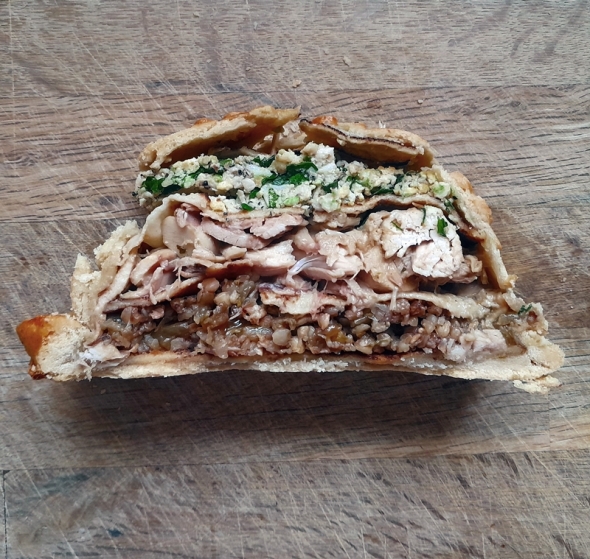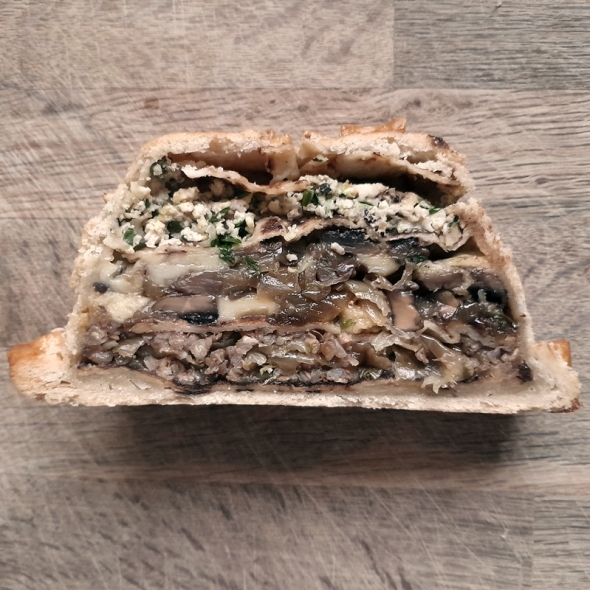Kurnik
Posted: February 2, 2024 Filed under: chicken, Deja Food, Flaky Pastry, Mains, Pastry, Puff Pastry, Rough Puff Pastry, Shortcrust, Traditional, vegetarian | Tags: buckwheat, chicken, egg, pie, Traditional, vegetarian Leave a comment
Kurnik Pies
Wotchers!
The recipe today is a wonderfully impressive layered pie from the Cossack regions of Ukraine and Russia. Its more famous cousin is the iconic Koulibiac, which is usually filled with either salmon or sturgeon, rice and eggs. Although less well-known in western countries, the Kurnic pedigree is equally, if not more, regal, and according to several Ukrainian and Russian websites, is actually the more famous in its homeland.
Before I get into the details, I’d just like to make the case for why this is a great recipe that you should consider trying. It’s not because it originated on the banquet tables of royalty, stuffed to the rafters with exotic meats. It is because it conjures a fantastic family – or individual – pie, from bits and bobs of almost nothing. It is also a great Deja Food pie, because all of the multiple fillings are already cooked before the pie is assembled. Now, in the recipe below, they are specifically cooked for this pie, but they could equally be gathered from spelunking the deepest, darkest recesses of your fridge as the end of the week approaches. With its distinct layers, it is a delightfully flavourful centrepiece for a meal that can be tailored or down, according to the ingredients you have to hand. The most famous version is made with chicken, but I have put together a vegetarian version that, personally, I enjoy more than the original. You can improvise your own version with your own favourite ingredients and maybe even create a new family recipe and tradition.
All of the information I have gathered for this recipe has been from websites in either Ukrainian or Russian, with the help of an online translator. Any and all errors are mine. If you do spot an absolute howler, please let me know so that I can correct it.
The origins of the pie are in the far distant past, where kurniks were baked as an offering to the sun god at the summer solstice by the pagan Slavs. Later, kurniks were a favourite dish on the banqueting tables of Ivan the Terrible and more recently, have become the traditional centrepieces of the wedding feast. The parents of the groom bake a kurnik for him decorated with human figures representing good wishes for new family.The bride’s parents present her with a kurnik decorated with flowers and plant motifs, symbolizing beauty and fertility. The better the pies turn out, the better the auspices for the marriage.
The shape of the pie makes it immediately recognisable and symbolic, although just what it is supposed to symbolise appears to be the subject of much discussion. It is a round pie, usually assembled on a sheet of pastry, with the additional ingredients piled high The whole is covered by another sheet of pastry and the bottom crust folded up and onto the top crust to form a broad rim. A hole is cut in the top to let out steam. This distinctive shape also contributes to the pie’s name, but the items it is likened to vary wildly. I have gathered the following from multiple sources, most of which I have had to decipher via online translators, so again, mea culpa for any errors.
- The name ‘kurnik’ can be translated as ‘chicken coop’ or ‘hen house’ – a fairly straightforward derivation since one of the main ingredients is chicken.
- Another variation is similar to the Ukrainian for ‘smoking’, in reference to the steam that comes from the top vent in the pastry.
- The pie’s name might also derive from ‘kuren’, which could either mean a division of the cossack army (who might well have dined on this all-in-one pie), or the traditional circular thatched huts from the region.

- Another nickname for the pie is “Monomakh’s Cap”, as with its elevated shape, decorated exterior and raised border at the base it resembles the oldest of the imperial crowns.

Monomakhs Cap
It’s not just the shape that is symbolic – the ingredients used in the filling are also filled with meaning, especially in relation to the wedding feast. The traditional fillings are grains, chicken and egg, the grains symbolising prosperity and the chicken and egg family continuity (although, if you ask me, sticking them both in a pie together is rather a continuity-ending move).
- Grains: the most traditional grain is buckwheat (kasha). Barley would also be suitable. Many modern recipes use rice, either white or brown. Caramelised onions and fresh herbs add colour, flavour and texture to this layer.
- Chicken: In the time of Ivan The Terrible, the filling was of more exotic meats such as duck, beef or lamb. Some regions even serve it with fish. Mushrooms are also a frequent ingredient in this layer, and the whole can be bound together with either a brown gravy or white sauce.
- Egg: Hard boiled eggs are chopped with fresh herbs, onions and butter.
The feature of kurnik that sets it apart from other pies is that each layer is interleaved with thin crepes or pancakes, which keep the layers neatly separated and as a bonus allows the pies to be cut into very attractive slices.

Cross-section slice of kurnik showing the traditional fillings of egg, chicken and buckwheat separated by pancakes.
Although not difficult, making a kurnik can be rather laborious. The good news is that each element – pancakes, fillings, pastry – can all be prepared the day before – or even a few days before, and then assembled when required.

Cross-section slice of a vegetarian kurnik showing layers of egg, mushrooms & onions, and buckwheat kasha separated by pancakes.
Kurnik
You can make your kurnik any size you like. Traditionally a single large pie, the kurniks in the photos are shaped in medium-sized pudding bowls, ideal for two people. You can even make them in individual pudding bowls, and reduce the cooking time even further. Since everything but the pastry is already cooked, they wont take long to bake at all. Below you will find instructions for four different fillings. Choose three. Or all four if you like, but three is traditional: eggs on top, grains on the bottom, protein in the middle. If you’re vegetarian, you can substitute the mushroom/onion/cheese filling for the chicken.
Pastry
I have used my favourite cornflour shortcrust pastry, but you could also use puff pastry if preferred, or even a mixture of the two (puff pastry top layer, shortcrust pastry base).
Egg Filling
The number of eggs will depend on how large you are making your pie and the number of servings. As a guide, for each person/serving use:
- 1 large hard-boiled egg, chopped
- 1-2 spring onions, sliced thinly
- 2 tablespoons of chopped parsley
- 1tbs butter
- salt and pepper to taste
Melt the butter in a pan and lightly cook the spring onion until softened. Stir through the egg and parsley and season to taste. Set aside until required.
Chicken Filling
This layer is formed of cooked chicken, ideally poached and allowed to cool in the cooking liquid to retain moisture. The quantity very much depends on how many people you are planning to serve with your pie, but 2 chicken breasts should be sufficient for a pie for four people. You can add more or less as you like.
Add cooked mushrooms if liked. I used a mixture of chestnut and regular button mushrooms, sliced and cooked slowly in butter and oil. Season well with salt and pepper.
Grains filling
2 cups of cooked grains (approx 1 cup dried). Choose from buckwheat, barley, basmati rice – white or brown, or couscous – large or small.
- Add any/all of the following to taste
- bunch of fresh dill – chopped
1-2 caramelised onions
salt and pepper
- bunch of fresh dill – chopped
Vegetarian filling
Mix together equal quantities (1 cup) of caramelised onions, cooked mushrooms and strongly flavoured grated/cubed cheddar cheese. Season well with salt and pepper.
Pancakes
120ml milk
1 large egg
60g plain flour
salt and pepper to taste
- Put all of the ingredients into a bowl and whisk together to form a smooth batter.
- Melt a little butter or oil in a frying pan and fry your pancakes.
- NB Each pie will require 4 pancakes of varying sizes. You can make small ones to the size you require, but I find it easier to get the desired thinness by making large pancakes and then cutting the size required from them by hand.
To Assemble
- Line the bowl or bowls you intend on using with cling film. This will help when turning out the pies for baking.
- Roll out the pastry for the top of the pie and lay it into the basin, leaving the excess overhanging the sides.
- Lay a pancake (or cut a suitable shape from your larger pancakes) in the bottom of the bowl.
- Add your filling. Be sure to pack it firmly, as it will give shape and firmness to your pie in the oven.
- Add your buttery egg filling .
- Add a pancake layer.
- Add the main protein filling – chicken, cheese & mushroom, or your own choice .
- Add a pancake layer.
- Add your grains filling. I like to use the grains filling to ensure the pie is completely filled.
- Finally, wet the pastry on the rim of your pie and lay over the pastry for the base. Press the edges together firmly. You will finish sealing the pastry just before baking.
- Lay a plate on top of the basin, with some extra weight if liked, and then chill the pie in the fridge to firm up for at least an hour or until baking.
- When ready to bake, heat the oven to 200°C, 180°C Fan.
- Remove the pie from the fridge and turn it out of the basin. Remove the cling film. Trim the excess pastry and fold the edges up and onto the sides of the pie. Cut decorative shapes from the spare pastry and attach to the pie by brushing the undersides with water, then pressing firmly onto the pie lid.
- Whisk an egg and then glaze the pie by brushing all over with the beaten egg.
- Finally, cut a vent hole in the top of the pie to let out the steam.
- Line a baking sheet with parchment and lay on your pie.
- Bake for 30-40 minutes for a small/medium pie, and up to 1 hour for a large pie, when the pastry will be cooked and golden brown, and the filling hot. Turn the baking sheet around halfway through to ensure even colouring.
- Serve with fresh vegetables and a sauce if liked – creamy mushroom or gravy are my suggestions.